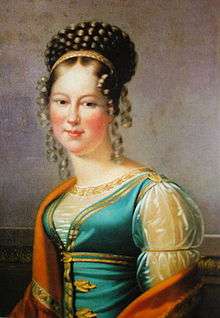Maria Antonia Koháry de Csábrág
| Princess Mária Antónia | |
|---|---|
|
Princess Ferdinand of Saxe-Coburg and Gotha Duchess in Saxony | |
 Princess Mária Antónia von Koháry | |
| Spouse(s) | Prince Ferdinand of Saxe-Coburg and Gotha |
| Noble family |
House of Koháry ' House of Saxe-Coburg-Gotha-Koháry |
| Father | Prince Ferencz József Koháry de Csábrág |
| Mother | Maria Antoinetta Josefa von Waldstein-Wartenburg |
| Born |
2 July 1797 Buda |
| Died |
25 September 1862 (aged 65) Vienna |
| Buried | Friedhof am Glockenberg, Coburg |
| Religion | Roman Catholicism |
Princess Mária Antónia von Koháry (2 July 1797 – 25 September 1862) was a Hungarian noblewoman and the ancestor of several European monarchs. She was the heiress of the Koháry family and one of the three largest landowners in Hungary.
Life
She was born in Buda, as Countess Maria Antonia Koháry de Csábrág et Szitnya, the second child of Franz Josef, Count Koháry and his wife, Countess Maria Antoinetta Josefa von Waldstein-Wartenburg.[1] Her older brother Franz died, aged two, on 19 April 1795. This left Antónia, from the moment of her birth, as the sole heir to the vast fortune of the House of Koháry.
She inherited over 150000 hectares of land in Lower Austria, Hungary and Slovakia, including estates, forests, mines and factories. According to a list of assets appended to the marriage contract of her son, Prince August, at the time of his marriage to Princess Clémentine of Orléans in 1843, the Koháry properties included the enormous Palais Koháry in the center of Vienna and several Viennese manors, a summer home and lands at Ebenthal, Lower Austria, estates in Austria at Velm, Durnkrut, Walterskirchen, Bohmischdrut and Althoflein, as well as a dozen manors in Hungary, the domaine of Kiralytia, and a mansion at Pest.[2] As late as 1868, when Antónia's grandson Prince Ferdinand, Duke of Alencon, married, it was estimated that he and his three siblings stood to inherit a total of a million francs just from their share of their late grandmother's estate.[2] Until the first world war, her descendants, the Koháry branch of the House of Saxe-Coburg and Gotha, were among the three largest landowners in Hungary.
On 30 November 1815, in Vienna, she married Prince Ferdinand of Saxe-Coburg and Gotha.[1] He was an elder brother of Prince Leopold, future King of the Belgians but then consort to Princess Charlotte of Wales, who was expected to inherit the crown of Great Britain, and also elder brother of the Duchess of Kent, mother of the future Queen Victoria.[2] To make her a suitable bride for a prince, the emperor had raised her father (whose ancestors had been created counts in the Hungarian nobility in July 1685 and barons in February 1616) to Prince Koháry of Csábrág and Szitnya in Austria's nobility on 15 November 1815, two weeks before the wedding, thereby allowing her to come to her bridesgroom already a princess.[1]
She died in Vienna in 1862, and was buried in the ducal mausoleum on the Friedhof am Glockenberg (Glockenberg cemetery) in Coburg.[3]
Marriage and issue
She and her husband became the parents of four children:[2]
- Prince Ferdinand of Saxe-Coburg and Gotha (1816–1885); he became King of Portugal as Ferdinand II in 1869; his grandson Ferdinand became King of Romania in 1914
- Prince August of Saxe-Coburg and Gotha (1818–1881); his son Ferdinand was elected Prince of Bulgaria in 1887 and was elevated to tsar (king) in 1908
- Princess Victoria of Saxe-Coburg and Gotha (1822–1857); her son Gaston was the consort of Isabel, Princess Imperial, daughter of the Emperor Pedro II of Brazil.
- Prince Leopold of Saxe-Coburg and Gotha (1824–1884)
The couple were also ancestors of Pedro V of Portugal, Luis I of Portugal, Charles I of Austria, Otto von Habsburg, Michael I of Romania, Peter II of Yugoslavia, Ferdinand I of Bulgaria, Boris III of Bulgaria, Simeon II of Bulgaria, Henri, Count of Paris, Prince Boris of Leiningen and Prince Hermann Friedrich of Leiningen,Pedro de Alcântara, Prince of Grão-Pará, and members of the Imperial House of Brazil alive today.
Titles and styles
- 2 July 1797 - 14 November 1815: Countess Maria Antonia Koháry de Csábrág
- 15 November 1815 - 1 January 1816: Princess Maria Antonia Koháry de Csábrág
- 2 January 1816 - 25 September 1862: Her Serene Highness Princess Maria Antonia of Saxe-Coburg and Gotha, Duchess of Saxony
Ancestors
| Ancestors of Maria Antonia Koháry de Csábrág | ||||||||||||||||||||||||||||||||||||||||||||||||||||||||||||||||||||||||||||||||||||||||||||||||||||||||||||||||||||||||||||||||||||||||||||||||||||||||||||||||||||||||||||||||||||||||||||||||||||||||||||||||||||||||||||||||||||||||||||||||||||||||||||||||||||||||||||||||||||||||||||||||||||||||||||||||||||||||||||||||||||||||||||||||||||||||||||||||||||||||||||||||||||||||||||||||||||||||||||||||||||||||||||||||||||||||||||||||||||||||||||||||||||||||||||||||||||||||||||||||||||||||||||||||||||||||||||||||||
|---|---|---|---|---|---|---|---|---|---|---|---|---|---|---|---|---|---|---|---|---|---|---|---|---|---|---|---|---|---|---|---|---|---|---|---|---|---|---|---|---|---|---|---|---|---|---|---|---|---|---|---|---|---|---|---|---|---|---|---|---|---|---|---|---|---|---|---|---|---|---|---|---|---|---|---|---|---|---|---|---|---|---|---|---|---|---|---|---|---|---|---|---|---|---|---|---|---|---|---|---|---|---|---|---|---|---|---|---|---|---|---|---|---|---|---|---|---|---|---|---|---|---|---|---|---|---|---|---|---|---|---|---|---|---|---|---|---|---|---|---|---|---|---|---|---|---|---|---|---|---|---|---|---|---|---|---|---|---|---|---|---|---|---|---|---|---|---|---|---|---|---|---|---|---|---|---|---|---|---|---|---|---|---|---|---|---|---|---|---|---|---|---|---|---|---|---|---|---|---|---|---|---|---|---|---|---|---|---|---|---|---|---|---|---|---|---|---|---|---|---|---|---|---|---|---|---|---|---|---|---|---|---|---|---|---|---|---|---|---|---|---|---|---|---|---|---|---|---|---|---|---|---|---|---|---|---|---|---|---|---|---|---|---|---|---|---|---|---|---|---|---|---|---|---|---|---|---|---|---|---|---|---|---|---|---|---|---|---|---|---|---|---|---|---|---|---|---|---|---|---|---|---|---|---|---|---|---|---|---|---|---|---|---|---|---|---|---|---|---|---|---|---|---|---|---|---|---|---|---|---|---|---|---|---|---|---|---|---|---|---|---|---|---|---|---|---|---|---|---|---|---|---|---|---|---|---|---|---|---|---|---|---|---|---|---|---|---|---|---|---|---|---|---|---|---|---|---|---|---|---|---|---|---|---|---|---|---|---|---|---|---|---|---|---|---|---|---|---|---|---|---|---|---|---|---|---|---|---|---|---|---|---|---|---|---|---|---|---|---|---|---|---|---|---|---|---|---|---|---|---|---|---|---|---|---|---|---|---|---|---|---|---|---|---|---|---|---|---|---|---|---|---|---|---|---|---|---|---|---|---|---|---|---|---|---|---|---|---|---|---|---|---|---|---|---|---|---|---|---|---|---|---|---|---|---|---|---|---|---|---|---|---|---|---|---|---|---|---|---|---|---|---|---|---|---|---|---|---|---|---|---|---|---|---|
| ||||||||||||||||||||||||||||||||||||||||||||||||||||||||||||||||||||||||||||||||||||||||||||||||||||||||||||||||||||||||||||||||||||||||||||||||||||||||||||||||||||||||||||||||||||||||||||||||||||||||||||||||||||||||||||||||||||||||||||||||||||||||||||||||||||||||||||||||||||||||||||||||||||||||||||||||||||||||||||||||||||||||||||||||||||||||||||||||||||||||||||||||||||||||||||||||||||||||||||||||||||||||||||||||||||||||||||||||||||||||||||||||||||||||||||||||||||||||||||||||||||||||||||||||||||||||||||||||||
Footnotes
- 1 2 3 "Kohary". Almanach de Gotha. Gotha, Saxe-Coburg and Gotha: Justus Perthes. 1825. pp. 3, 106–107.
- 1 2 3 4 Paoli, Dominique (2006). Fortunes & Infortunes des Princes d'Orléans. France: Editions Artena. pp. 107, 113, 372. ISBN 2-35154-004-2.
- ↑ Harald Sandner: Das Haus Sachsen-Coburg und Gotha 1826 bis 2001; Eine Dokumentation zum 175-jährigen Jubiläum des Stammhauses in Wort und Bild, Neue Presse, Coburg, 2001, ISBN 3-00-008525-4, p. 321
References
- Marek, Miroslav. "Koháry de Csábrág et Szitnya Family".
- Otto Posse: Die Wettiner, Leipzig, 1891
External links
- http://www.zeno.org/Brockhaus-1911/A/Koh%C3%A1ry
- http://www.gda.bayern.de/findmittel/pdf/staco_kohary_001_2009.pdf (PDF; 319 kB)
- http://genealogy.euweb.cz/hung/kohary.html